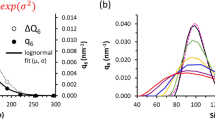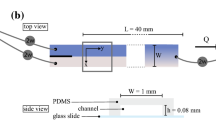Abstract
A single-camera coupled particle tracking velocimetry–laser-induced fluorescence (PTV–LIF) technique and validation results from an experiment in a neutrally buoyant turbulent round jet are presented. The single-camera implementation allows the use of a 12-bit 60 frame-per-second 1024 × 1024 pixel digital CCD camera capable of streaming images in real time to hard disk resulting in very accurate PTV and LIF with excellent spatial and temporal resolution. The technique is capable of determining the turbulent scalar flux, as well as the Reynolds stress and mean and fluctuating velocity and concentration fields. Details of dye choice, corrections for attenuation due to dye, particles and water, photobleaching, vignetting, CCD calibration, and illumination power and geometry corrections are presented. Detailed results from the validation experiment confirm the accuracy and resolution of the technique, and in particular, the ability to measure . Bootstrap 95% uncertainty intervals are presented for the calculated statistics.
Similar content being viewed by others
Author information
Authors and Affiliations
Additional information
Received: 28 July 2000/Accepted: 8 November 2000
Rights and permissions
About this article
Cite this article
Cowen, E., Chang, KA. & Liao, Q. A single-camera coupled PTV–LIF technique. Experiments in Fluids 31, 63–73 (2001). https://doi.org/10.1007/s003480000259
Issue Date:
DOI: https://doi.org/10.1007/s003480000259




